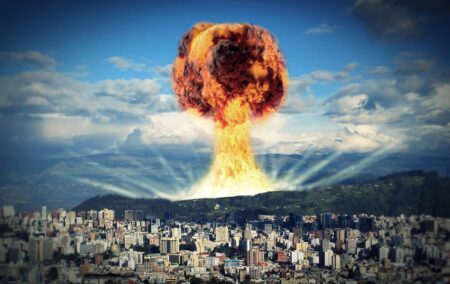75 years ago, on 6 August 1945, just before 08h15, some anxious Japanese heard a sound above. Fearful of what the skies might bring, they looked up. To their relief, they saw only a single plane, high in the sky. Something fell from it. 53 seconds later there was a dazzling white flash that lit up the sky above the lovely city of Hiroshima.
On 30 January 1933, Adolf Hitler became the Chancellor of Germany. He immediately proceeded to do what he had promised: he destroyed democracy, persecuted Jews and prepared for a colossal war of conquest. Many Jews fled Germany. One was Albert Einstein, a physicist, who knew that the nuclear force had the potential to unleash enormous energy but thought mankind could never tap it.
On 12 July 1939, Leo Szilard, a Hungarian physicist, visited Einstein in New York and showed him something that frightened him. He said, ‘Daran habe ich gar nicht gedacht’ (‘I never thought of that’). Szilard showed him the possibility of a nuclear fission chain reaction using neutrons and uranium nuclei. In August, Einstein wrote to President Roosevelt, explaining that it might be possible to build a nuclear bomb with explosive force unimaginably greater than any conventional bomb, and that Hitler’s scientists might be making one. The Second World War began on 3 September 1939. The Americans started the Manhattan Project, to try to build such a bomb. On 16 July 1945, in their Trinity atomic bomb test in New Mexico, they succeeded.
By then, multitudes had been killed, cities had been reduced to rubble, Hitler had committed suicide and Germany had surrendered. But the Japanese fought on. They had no hope of victory but refused to surrender. There was horrible loss of life as the Americans captured the islands around Japan. The new American President, Harry Truman, faced two ghastly possibilities. One was the invasion of the Japanese, which would have cost over ten million lives. The other was continued conventional bombing by the big fleet of appallingly efficient four-engine bombers of Britain and America, which had already laid waste to whole cities in Germany and Japan. Then Truman was told about Trinity – and realised there was a third possibility.
Hell on Earth
After it had dropped the bomb on Hiroshima, the Enola Gay, a B29 American bomber, flew off as quickly as possible, and was 7 km away when the bomb exploded. The cabin was lit up. Shock waves buffeted the plane. One of the crew looked down and saw a great dark cloud where Hiroshima had been. Below the cloud was hell on Earth.
It was not the radiation that did the most damage. (Sixty years after the bomb, the excess cancers from the radiated survivors were surprisingly few, and there were no genetic effects.) What caused it was the blast and, much worse, the heat, the terrible heat, unlike anything ever before felt on Earth. The lucky ones were incinerated or reduced to piles of charcoal or lumps of roasted meat sticking to walls and pavements. The unlucky ones were mutilated or half roasted. People had the front of their bodies burnt off, so that their intestines fell out of them, while their backs were untouched. A man had his jaw blown off, with his tongue dangling from the hole under his face. A woman stumbled forward with her eyeballs hanging out of their sockets. 140 000 died.
On 9 August 1945, the second bomb was dropped, on Nagasaki. On 15 August, Japan surrendered, and the Second World War was over.
I have no doubt that President Truman was right to drop the bombs. Nothing else could have made Japan surrender then, and continued fighting would have cost untold more lives than the bombs did. My father, a seaman who had been up against the German U-boats in the Atlantic, told me his reaction when he heard the news: ‘Thank God!’ Every other serviceman that I have spoken to who was there at the time said the same.
Extraordinary success story
After 1945, Japan became an extraordinary success story. Its gangster dictatorship was replaced with democracy. Its economy boomed and gave the world a bounty of wonderful manufactured goods, including motorcars, motorbikes, cameras and electronics. Before the war, Japan felt it had to invade foreign lands to get food, oil and other resources; after the war, with a bigger and more prosperous population, it could easily get all the food and resources it needed by peaceful trade.

I visited Hiroshima in 2005. A charming city, fresh, clean, prosperous and pretty, with demure, friendly people. There is no evidence anywhere of the bomb, except at the memorial, which I visited. It is a haunting place. I saw the ‘Atomic Bomb Dome’, the steel skeleton of the dome on top of the ruins of what had been the Hiroshima Prefectural Industrial Promotion Hall. In the museum, I stopped before a glass-covered drawer and stared at the famous watch, a cheap and ordinary little thing, with its hands stopped forever at 08h15.
The views of the writer are not necessarily the views of the Daily Friend or the IRR
If you like what you have just read, subscribe to the Daily Friend
Image by Cristian Ibarra from Pixabay

